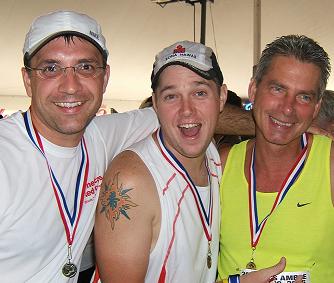#1 (strictly numbers):
Posted By Mark Iocchelli On 8th June 2007 @ 08:03 In Weight Loss | 13 Comments
There was a nice little table in [1] Runner’s World this month that illustrates how much faster you could be if you lost weight. Of course, this would not take into account speed increases due to training.
| Pounds Lost | 5k | 10k | 1/2 Marathon | Marathon |
| 2 | :12.4 | :25 | :52 | 1:45 |
| 5 | 31 | 1:02 | 2:11 | 4:22 |
| 10 | 1:02 | 2:04 | 4:22 | 8:44 |
| 20 | 2:04 | 4:08 | 8:44 | 17:28 |
According to RW author Amby Burfoot, the table is based on research that runners, on average get 2 seconds per mile faster for every pound they lose. The times you see above are the amounts a runner can shave off his/her race times by losing weight.
Feel motivated?
———
Note: Weight loss is for people who are overweight - not for people who are already slim. Losing weight when you are slim means you are losing muscle tissue and that means you are losing strength which in turn makes you slower. If at all in doubt, discuss with a professional (a doctor or your coach).
Article printed from Complete Running Network: http://completerunning.com
URL to article: http://completerunning.com/archives/2007/06/08/lose-weight-get-faster/
URLs in this post:
[1] Runner’s World: http://runnersworld.com
#2 (science behind numbers):
Running Lessons from Isaac Newton
Posted By Jank On 25th June 2007 @ 08:30 In Weight Loss | No Comments
A while back, [1] Mark posed the question to me: “Hey, Bill? How does having lost weight change my running? As in: I know it makes me faster, but can you quantify that?”
Being an engineer, I was tempted to snap back that I’d spent four years and a decent part of my potential life’s income learning how to answer those questions. Then, I was afraid that all that knowledge had slipped under the bridge, and I wouldn’t actually be able to answer the question…
Ah, but fear not, readers - the years and the beers haven’t completely eroded Physics 101. In fact, thanks to good old aerobic exercise, I’m [2] likely smarter now than back in college when my exercise regime consisted largely of 12 oz curls.
We’ll start at the beginning, with [3] Newton’s famous
F = M * A
or, Force = Mass times Acceleration.
Rearrange this a bit, and we can see that
Acceleration = Force divided by Mass (A = F / M )
So, off the line, dropping, say, 15 lbs off of a 150 lb frame will make you able to accelerate 10% faster, assuming that none of the weight loss came out of muscle tissue.
There’s a similar benefit to be had in climbing - climbing is just vertical acceleration, with the earth’s gravity trying to pull you down with a constant acceleration of 9.8 meters / second squared. 1Weight reduction means that you can climb at the same rate using less force where the rubber meets the road.
I’m sure that everyone has heard Newton’s other law about “An object in motion tends to stay in motion until acted upon by an external force”. Well, strictly speaking, that’s true. However, we’ve got plenty of external forces to deal with. There’s wind drag, which we’ll deal with later, but more importantly, there’s gravity.
For those of us in the real world, we really aren’t moving straight forward as we run. In reality, we’re tracing a series of arcs as we push off with one foot, raise our center of gravity up as we push off, experience a brief bit of weightlessness at the top of each stride, get pulled back down to earth by gravity, foot strike, store energy in our legs, and push off again (Yes, yes, Mr. [4] Pose - as much as we try to float our feet in circles, there is still effort involved).
Every time we push off to enjoy that delicious moment of weightlessness in each stride, we’re doing work. In the engineering sense, Work is defined as Force over a distance. In our case, each step involves the work needed to lift up our bodies enough to swap feet, and enough work to overcome hills and aerodynamic drag.
Assuming that drag remains constant regardless of weight (a bad assumption, as cross-section goes down as we get skinny, but I don’t feel like hitting Wikipedia for that one), with each step we’re going to have to lift our body up. 10% weight reduction means that each step we’re doing requires 10% less work with each step, requiring 10% less power (work times time) to maintain a given velocity.
OR, again, with the assumption that you’re not losing power as you lose weight, you can go faster with the same amount of muscles if you’re skinnier.
Picture it this way: Say you lose 5 pounds. 5 pounds is about the same as a half-gallon of milk. I were to ask you to lift a thousand half-gallons of milk onto a 6″ stair, you’d think it was a tough, tough task. Losing 5 lbs is like not having to lift that 500 gallons of milk in every mile you run.
——-
Editors Note: Whether you should lose weight or not is something you should discuss with a professional such as your doctor or coach. We do not advocate that young athletes try to lose weight just to get faster.
Article printed from Complete Running Network: http://completerunning.com
URL to article: http://completerunning.com/archives/2007/06/25/speed-lessons-isaac-newton/
URLs in this post:
[1] Mark: http://completerunning.com/running-blog-mark
[2] likely smarter: http://www.cnn.com/2003/HEALTH/10/17/improve.memory/
[3] Newton’s: http://en.wikipedia.org/wiki/Newton's_laws_of_motion
[4] Pose: http://posetech.com


No comments:
Post a Comment